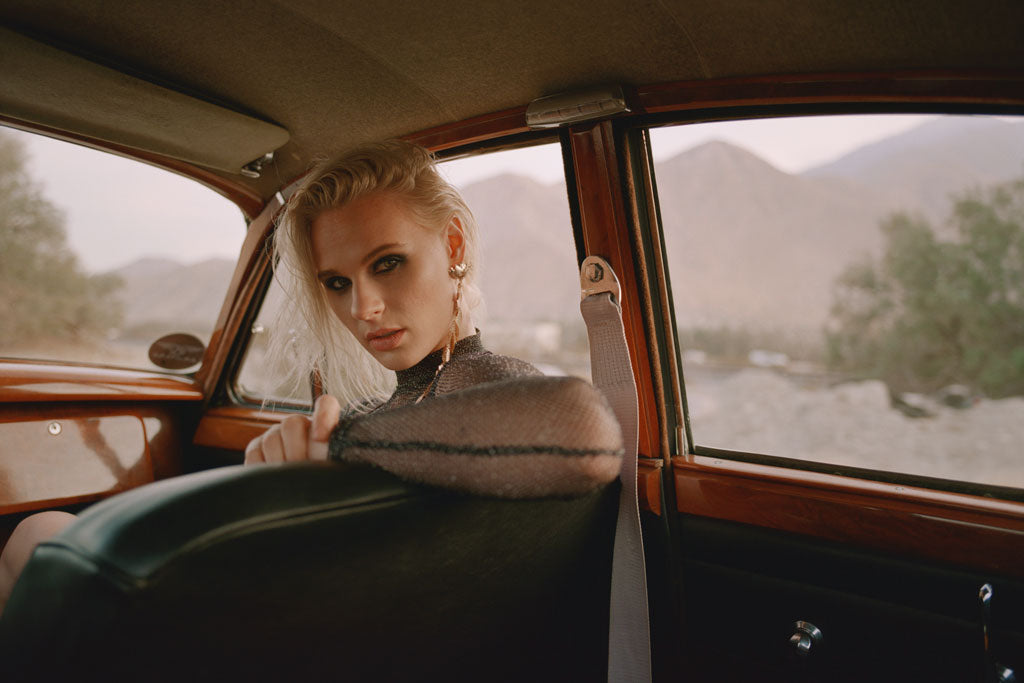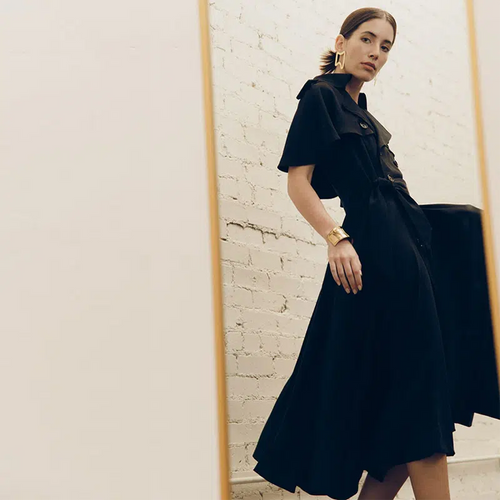
A scroll through photographer Alexander Morgan's portfolio — or his Instagram, for that matter — will reveal images that carry a level of maturity and depth rarely seen from an artist who isn't yet 30-years-old. But after chatting with the 28-year-old photographer, who lives in Brooklyn, it becomes apparent that Morgan is wise for his years. He grew up a citizen of the world, with a childhood spent living in the US, Germany and South Korea. Equal parts creative and technical, Morgan studied computer programming before falling into photography — an artistic practice that soon became an obsession and a career.
In a nod to nostalgia and creative spontaneity, Morgan prefers film over digital photography. And while his work is dynamic, to be sure, it also embodies a profound stillness. The result is a perfect pairing of drama and solitude, with compositions that effortlessly pair shape and silhouette in a sublime world of carefully crafted light. Morgan aims to depict real women in moments of strength, exemplifying their natural beauty in a thoughtful and modern way. So when it came time to produce a campaign for Eve & Max's inaugural collection, founder Max Trowbridge knew Morgan would be the perfect lensman. We caught up with Morgan, post-shoot, to chat all things photography, inspiration in the time of Covid-19 and reshaping traditional definitions of beauty.
Before we dive into your work, tell me about your early years. You were a bit of a globetrotter.
My father was in the Air Force. So, I don't really have a hometown, per se. We moved every two or three years; we spent a lot of time on the east coast and in the south, and then went to Germany and South Korea. What I call my 'faux home' is Germany. My time living there really shaped me as a person. I was in the fifth grade, and we were in Stuttgart for three years. My parents pulled my brother and me out of the American school system — and we had to learn German and attend the German school in the local neighborhood where we were living.
 Lensman, Alexander Morgan
Lensman, Alexander Morgan
That must have been quite the culture shock — especially for being so young.
My brother and I are half black and a quarter Indian. We were the only darker-skinned people there. It was a bit of a shock to be this poster American person in a European school, but everyone was super friendly and open. Having had that experience, I've always gravitated toward European culture, values and way of life. With work, I've been lucky to travel back to Europe a lot. It has shaped the aesthetic that I have, with anything from interior design to clothing.
How did you first fall in love with photography?
Funny enough, I went to college for computer programming. But I always had a creative background as a kid — I was always building things and making things. [Years later] when I was living in New York, a friend of mine who's a photographer would stay with me. He taught me the basics of how a camera works. He shoots all on film, and it was a huge learning curve. At some point, I decided to invest in a camera and try to learn it. It was by accident that I got really into photography. A good friend of mine from high school, who used to take photos of us when we were skateboarding, came to visit and helped me get more familiar with the technical aspects of photography. It snowballed into a career change. I quickly became obsessed.
Your work has a profound stillness to it. Describe your creative ethos as an artist.
There is a sort of calmness to a lot of the photos that I post, which is a bit of an anomaly for me because people would probably describe me as very energetic and chaotic — loud, I guess. The ethos for my photos, especially when I'm photographing women, is to try and find a way to make women feel empowered and beautiful. I want to try and show a strong woman — and to make someone realize that everyone is beautiful in their own way and then capture that moment. I really enjoy working with friends who aren't classically trained models. Working outside of the preconceived notions of how to "model" often leads to more authentic moments. Sharing the end results is always the most gratifying part. What I really try to focus on is making someone feel comfortable — and finding interesting moments with lighting to make it compelling.
How the fashion world defines beauty is in rapid flux. How do you define beauty?
There's definitely been a shift in the industry's beauty standard. I hope it's not performative. For so many years, it was fair skin, light features, straight hair. Now, we're celebrating all different backgrounds, body types and cultures — and we're realizing we should have been doing it this whole time. These are beautiful human beings that have so much more depth than just a person on a magazine cover. That depth comes with diversity, and being a little bit more progressive with our decisions. When it comes to people, beauty is all about energy.
If you could shoot anything, anywhere what would it be?
I would love to do more reportage and documentary-style photography in places like Africa and the Middle East and capture the environment, the people, and the characters there. Everything that's happening in those places doesn't get captured enough — and I don't think there's a lot of well-deserved attention being focused on places like that.
The images you captured for Eve & Max are stunning. What was the creative process like working with stylist Sabrina Dee and founder Max Trowbridge?
It was a collaborative process. Sabrina, Max and I worked really closely on this one, everything from casting to the creative art direction of the shoot. The process is what really stood out to me. This was well planned out and very intentional in terms of what we wanted to get out of it. After seeing the clothes, I became very excited about shooting the robes. What I enjoy shooting is always very dramatic, but very still: It's a bit stoic. It's a robe catching the wind in a very surreal moment. We shot in Williamsburg. We built a very small set, where we shot the interior moments — and then on the roof deck for the skyline.
From the global pandemic to civil rights issues, we are in unprecedented times. Where are you finding inspiration right now?
It's honestly hard. In the beginning of the pandemic, I was really driven and motivated to do a self-portrait series. But as I started seeing more and more things happen, I took a hit and became unmotivated. There were two or three months that I couldn't find any inspiration. There were too many things going on — the global pandemic, the BLM movement, which really hit home to me. At some point, I had to push myself to be with people, who really helped me get back in the flow of things. After that, I started to slowly gain inspiration. It's hard to get inspired in moments like this. But once you start the embers, you can get the fire back.
Your preference is to shoot in film.
Film is the process that I work most comfortably in — and it's the look that I enjoy about the photos I take. It's more of an observation. I don't think I get the same results with a digital camera.
Working in film is a completely different mindset than digital. There's no instant gratification. You don't quite know what you captured until the film is processed.
It changes the entire way that you shoot. You're more conscious of what image you're trying to get, but you have to trust your instincts. I'm more present when I'm shooting film. I'm not looking back and pulling myself away from the space that I'm sharing with the subject. It's not a step-in-step-out process where you're just chasing an image. It's always an image that I totally forgot about that I end up loving the most. It's spontaneity, in a way: The spontaneity of getting your film back and realizing, 'Oh, that was a beautiful mistake.'
Who do you admire artistically speaking?
I've become quite close with Laurie Bartley. I've been fortunate enough to travel with him and see him work. His process is unreal. He is so intentional, I haven't seen anyone work like that. We were in this small, very old town in Morocco and he had an image in his mind of a herd of sheep surrounding a car and a woman. We didn't have any resources out there, but he was able to find a shepherd and find a car. It's humbling to be able to work with someone who has such a strong vision and is able to make it come to life.
Gregory Crewdson is another. He shoots in these sets that mimic a highly dramatized movie scene. It's kind of dark. It's kind of eerie. There's a very cinematic feel to his work, and it's very beautifully shot. That's the kind of work I would like to do in the long run — building these worlds and shooting in a way that feels like a movie still, with a narrative behind it. As a fashion photographer, Helmut Newton is another inspiration. He is a legend. His body of work has inspired so many photographers. Visit: Alexander R. Morgan.


Leave a comment